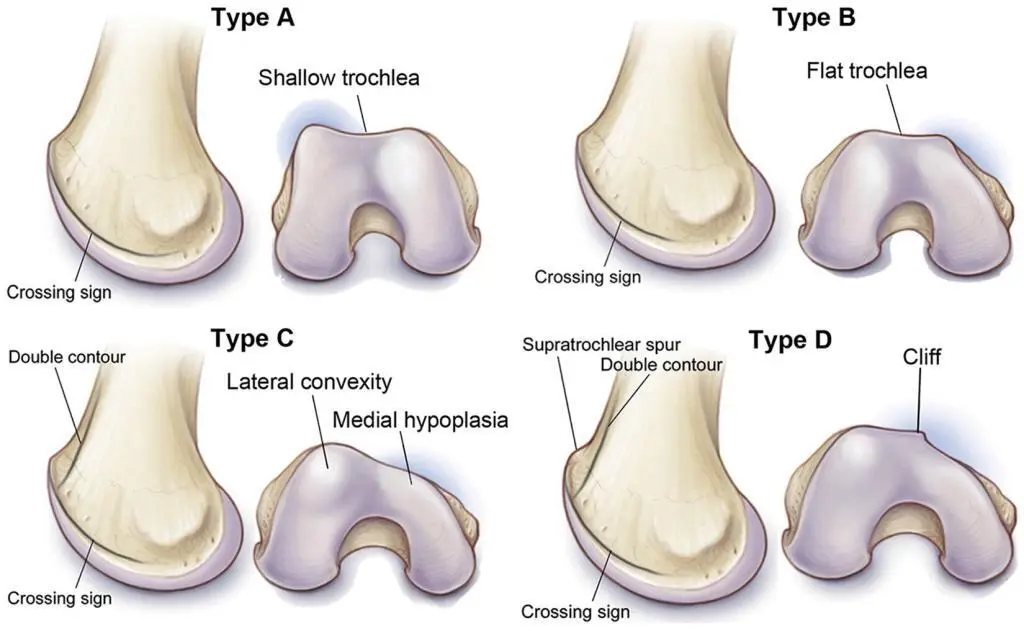If you experience a patellar dislocation, you may notice:
Some people also report recurring dislocations, a condition known as patellar instability.

Diagnosis typically includes:
Most first-time dislocations without significant bone or ligament damage are treated non-surgically.
The dislocated kneecap is gently manipulated back into place by a medical professional.
Use of a brace or knee immobilizer for 2–3 weeks to allow soft tissues to heal.
A targeted rehab program focusing on:
Avoiding high-impact sports until full recovery is achieved.
Surgery may be necessary for:
The medial patellofemoral ligament is rebuilt using a graft, typically from the hamstring tendon, to prevent future dislocations.
The bony attachment of the patellar tendon is repositioned to improve patella tracking.
A surgical reshaping of the femoral groove to better contain the patella (reserved for complex cases).
Removal of loose bodies and repair of cartilage damage.
Walking may be painful initially, but with proper treatment and bracing, many patients regain mobility quickly.
Up to 30-40% of first-time dislocators may experience recurrence, especially without rehab or in cases with anatomical abnormalities.
No. Many people recover fully with non-operative treatment, especially after a first-time injury.
Patellar dislocations can be painful and disruptive, but effective treatments exist for both acute injuries and chronic instability. Early diagnosis, appropriate rehab, and surgical intervention (when necessary) offer excellent outcomes for most patients.
If you’re dealing with knee instability or have experienced a dislocated kneecap, speak to an orthopedic specialist. Early intervention can reduce your risk of long-term issues and get you back to your active lifestyle safely.
What is a Patellar Dislocation? A patellar dislocation occurs when the kneecap (patella) moves out of its normal groove on the femur (thigh bone), typically shifting to the outside of the knee. This injury is most common in young athletes but can affect individuals of any age. Dislocations can happen due to trauma, such as a fall or sports injury, or because of anatomical predispositions like shallow trochlear grooves or ligament laxity.
If you experience a patellar dislocation, you may notice:
Some people also report recurring dislocations, a condition known as patellar instability.

Diagnosis typically includes:
Most first-time dislocations without significant bone or ligament damage are treated non-surgically.
The dislocated kneecap is gently manipulated back into place by a medical professional.
Use of a brace or knee immobilizer for 2–3 weeks to allow soft tissues to heal.
A targeted rehab program focusing on:
Avoiding high-impact sports until full recovery is achieved.
Surgery may be necessary for:
The medial patellofemoral ligament is rebuilt using a graft, typically from the hamstring tendon, to prevent future dislocations.
The bony attachment of the patellar tendon is repositioned to improve patella tracking.
A surgical reshaping of the femoral groove to better contain the patella (reserved for complex cases).
Removal of loose bodies and repair of cartilage damage.
Walking may be painful initially, but with proper treatment and bracing, many patients regain mobility quickly.
Up to 30-40% of first-time dislocators may experience recurrence, especially without rehab or in cases with anatomical abnormalities.
No. Many people recover fully with non-operative treatment, especially after a first-time injury.
Patellar dislocations can be painful and disruptive, but effective treatments exist for both acute injuries and chronic instability. Early diagnosis, appropriate rehab, and surgical intervention (when necessary) offer excellent outcomes for most patients.
If you’re dealing with knee instability or have experienced a dislocated kneecap, speak to an orthopedic specialist. Early intervention can reduce your risk of long-term issues and get you back to your active lifestyle safely.